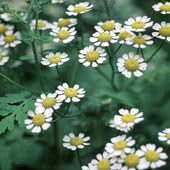Feverfew
Keywords: bachelor's buttons, featherfew, migraine headaches

© Steven Foster
On this page:
- Introduction
- What It Is Used For
- How It Is Used
- What the Science Says
- Side Effects and Cautions
- Sources
- For More Information
Introduction
This fact sheet provides basic information about the herbA plant or part of a plant used for its flavor, scent, or potential therapeutic properties. Includes flowers, leaves, bark, fruit, seeds, stems, and roots. feverfew—common names, uses, potential side effects, and resources for more information. Originally a plant native to the Balkan mountains of Eastern Europe, feverfew—a short bush with daisy-like flowers—now grows throughout Europe, North America, and South America.
Common Names—feverfew, bachelor's buttons, featherfew
Latin Names—Tanacetum parthenium, Chrysanthemum parthenium
What It Is Used For
- Feverfew has been used for centuries for fevers, headaches, stomach aches, toothaches, insect bites, infertility, and problems with menstruation and with labor during childbirth.
- Recently, feverfew has been used for migraine headaches and rheumatoid arthritis.
- Feverfew has also been used for psoriasis, allergies, asthma, tinnitus (ringing or roaring sounds in the ears), dizziness, nausea, and vomiting.
How It Is Used
- The dried leaves—and sometimes flowers and stems—of feverfew are used to make supplements, including capsules, tablets, and liquid extracts.
- The leaves are sometimes eaten fresh.
What the Science Says
- Some research suggests that feverfew may be helpful in preventing migraine headaches; however, results have been mixed and more evidence is needed from well-designed studies.
- One study found that feverfew did not reduce rheumatoid arthritis symptoms in women whose symptoms did not respond to conventional medicines. It has been suggested that feverfew could help those with milder symptoms.
- There is not enough evidence available to assess whether feverfew is beneficial for other uses.
- NCCAM-funded researchers are studying ways to standardize feverfew; that is, to prepare it in a consistent manner. Standardized preparations could be used in future studies of feverfew for migraines.
Side Effects and Cautions
- No serious side effects have been reported for feverfew. Side effects can include canker sores, swelling and irritation of the lips and tongue, and loss of taste.
- Less common side effects can include nausea, digestive problems, and bloating.
- People who take feverfew for a long time and then stop taking it may have headaches, nervousness, difficulty sleeping, stiff muscles, and joint pain.
- Women who are pregnant should not use feverfew because it may cause the uterus to contract, increasing the risk of miscarriage or premature delivery.
- People can have allergic reactions to feverfew. Those who are allergic to other members of the daisy family (which includes ragweed and chrysanthemums) are more likely to be allergic to feverfew.
- Tell your health care providers about any complementary and alternative practices you use. Give them a full picture of what you do to manage your health. This will help ensure coordinated and safe care.
Sources
- Awang DVC, Leung AY. Feverfew (Tanacetum parthenium). In: Coates P, Blackman M, Cragg G, et al., eds. Encyclopedia of Dietary Supplements. New York, NY: Marcel Dekker; 2005:211–217.
- Feverfew. Natural Medicines Comprehensive Database Web site. Accessed on July 5, 2007.
- Feverfew (Tanacetum parthenium L. Schultz-Bip.). Natural Standard Database Web site. Accessed on July 3, 2007.
For More Information
- What's in the Bottle? An Introduction to Dietary Supplements
- Herbal Supplements: Consider Safety, Too
NCCAM Clearinghouse
The NCCAM Clearinghouse provides information on CAM and NCCAM, including publications and searches of Federal databases of scientific and medical literature. The Clearinghouse does not provide medical advice, treatment recommendations, or referrals to practitioners.
Toll-free in the U.S.: 1-888-644-6226
TTY (for deaf and hard-of-hearing callers): 1-866-464-3615
Web site: nccam.nih.gov
E-mail:
CAM on PubMed
Web site: nccam.nih.gov/camonpubmed/
NIH Office of Dietary Supplements
Web site: ods.od.nih.gov
This publication is not copyrighted and is in the public domain. Duplication is encouraged.
NCCAM Publication No. D342
Created December 2006
Updated April 2008
Note: PDF files requires a viewer such as the free Adobe Reader.
